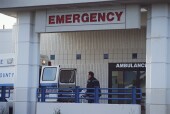
TUESDAY, May 17 (HealthDay News) — U.S. cities have lost almost 30 percent of their hospital emergency rooms in the past 20 years, while patient visits to ERs jumped by more than 35 percent, new research shows.
And the closures disproportionately affect “safety net” emergency rooms, meaning those serving patients who are poor, publicly insured or uninsured — people without access to traditional avenues of health care, according to a study in the May 18 issue of the Journal of the American Medical Association.
The implications include longer waits at remaining ERs, including those in higher-income communities, overcrowding and reduced access to medical care, experts said.
“If people don’t have an ER in their community, it’s not that their emergency room just disappears. They go to another ER, which could be another community and that increases crowding, and there’s good literature to show that crowding does affect patient outcomes,” explained study author Dr. Renee Y. Hsia, an assistant professor of emergency medicine at the University of California, San Francisco.
“This is furthering an already difficult problem, which is access to primary care getting more and more difficult,” said Dr. Jeremy Finkelstein, director of emergency services at the Methodist Hospital, in Houston.
Market forces, such as competition and dwindling profits, explain most of the closings, said the researchers, who originally set out to study increasing reports of ER overcrowding.
U.S. emergency rooms must treat everyone who enters their doors, regardless of their ability to pay. This does not mean that patients aren’t billed, but hospitals often aren’t able to collect on those bills and therefore go uncompensated.
Hsia and her co-authors looked at American Hospital Association data from 1990 through 2009 on emergency department closures at hospitals in the United States.
They correlated that information with financial data on individual hospitals and patient mix (uninsured, publicly insured, privately insured) culled from Medicare reports.
During the two decades studied, the number of emergency rooms at urban hospitals plummeted from 2,446 to 1,770, a 27 percent drop. More than 1,000 emergency departments closed (an average of 89 a year), and only 374 new ERs opened.
Of those ER closures, 66 percent were in hospitals that shut down. In the other cases, the hospital stayed open.
The ERs that closed were more likely to be in hospitals that operated for-profit (compared to nonprofit or government-run hospitals), hospitals making little profit, those in competitive markets or in safety-net hospitals.
“Some of these institutions have health-care margins of 3-to-5 percent on a good day, which in any other business would be a non-starter,” said Finkelstein.
ERs in smaller communities and areas with higher proportions of minorities and uninsured individuals were also more likely to close.
Lack of reimbursement seemed to be a main reason for the closures. This could be either because the patient was uninsured or because Medicaid reimbursements weren’t sufficient to cover costs.
Heavier use of emergency rooms is driven in part because people on Medicare or those who lack insurance don’t have access to basic preventive and primary care elsewhere.
While acknowledging that their study did not explore all the factors that might have contributed to ER closings, including politics or the recent recession, the authors point to serious shortcomings in the current policy governing closures. Market-based approaches to health care don’t guarantee equitable distribution of care, they said.
Other studies have looked at individual ER closings, Hsia said, but few have addressed the overall picture — “the overall explanation for more crowding and why people’s experiences in the emergency department are, on the whole, terrible.”
More information
Visit the American Academy of Emergency Medicine for more on this specialty.

